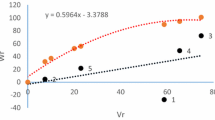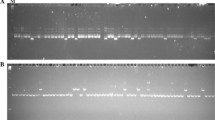Summary
A comparison between Griffing's (1956) Method 1, Model I, and Method 3, Model I, using data from a 10 × 10 diallel of spring barley grown in eight different environments, revealed that inclusion of the parental generation (Method 1) caused considerable upward bias in the estimates of both the general and specific combining ability variances, whereas its exclusion (Method 3) from the analysis resulted in similar GCA∶SCA ratios in all the environments. This investigation supports the exclusion of the parental generation in combining ability analyses. The proportion of general combining ability variance was much higher than that of the specific combining ability variance although both were statistically significant. The interaction of the former with environment was much higher than that of the latter. Except for combining ability variances, the estimates of GCA and SCA effects were found to be alike in both Method 1 and Method 3. Mean performance was correlated with the general combining ability effects. Variety Cb 824 proved to be the best general combiner for earliness; it could be usefully exploited in future breeding programmes to induce earliness, as this variety possesses mostly dominant genes for earliness. Early varieties such as Otis, Bonus M-12a and Line 7-2 were also good combiners for earliness. Crosses between these varieties generally showed high specific combining ability effects.
Similar content being viewed by others
Literature
Beil, G. M., Atkins, R. E.: Estimates of general and specific combining ability in F1 hybrids for grain yield and its components in grain sorghum, Sorghum vulgare Pers. Crop Sci. 7, 225–228 (1967).
Griffing, B.: Concept of general and specific combining ability in relation to diallel crossing system. Australian J. biol. Sci. 9, 463–493 (1956).
Hayman, B. I.: The theory and analysis of diallel crosses. Genetics 39, 789–809 (1954).
Liang, G. H.: Diallel analysis of agronomic characters in grain sorghum, Sorghum vulgare Pers. Canad. J. Genet. Cytol. 9, 269–276 (1967).
Matzinger, D. F., Sprague, G. F., Cockerham, C. C.: Diallel crosses of maize in experiments repeated over locations and years Agron. J. 51, 346–350 (1959).
Paroda, R. S., Joshi, A. B.: Genetic architecture of yield and components of yield in wheat. Indian J. Genet. 30, 298–314 (1970).
Paroda, R. S., Hayes, J. D.: An investigation of genotype-environment interactions for rate of ear emergence in spring barley. Heredity 26(2), 157–176 (1971).
Rojas, B. A., Sprague, G. F.: A comparison of variance components in corn yield trials. III. General and specific combining ability and their interactions with locations and years. Agron. J., 44, 462–466 (1952).
Singh, R. B., Gupta, M. P.: Combining ability for yield characters in upland cotton. Indian J. Genet. 30, 608–618 (1970).
Author information
Authors and Affiliations
Additional information
Communicated by W. Seyffert
Rights and permissions
About this article
Cite this article
Hayes, J.D., Paroda, R.S. Parental generation in relation to combining ability analysis in spring barley. Theoret. Appl. Genetics 44, 373–377 (1974). https://doi.org/10.1007/BF00303479
Received:
Issue Date:
DOI: https://doi.org/10.1007/BF00303479




